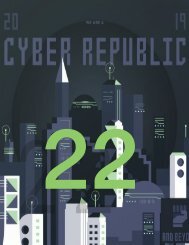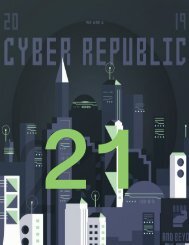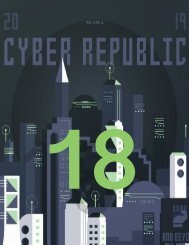Cyber Republic Weekly Update 23
Elections are already underway and members of the Cyber Republic are getting excited for Phase 5,when elected DPoS nodes will fully be deployed and begin finalizing Elastos’ Dual AuxPOW and DPoS Consensus mechanism. This week, the Elastos in a Nutshell Team came out with a comprehensive video and article about Computer Networks and how it relates to Elastos Carrier. Popular YouTuber Crypto Lark released with an all encompassing Elastos video that was very well received by the community, as it was fair in both praise and critique of Elastos. The Elastos private net has been fully updated. The ELA Republic, an Elastos Community Telegram Group, hosted Elastos’ Feng Han in an AMA. We also have an interview with Su Yipeng--Interim Council Member of the CR, updates from the Philippines community, a discussion on FUD and potential vectors of manipulation in DPoS voting and Consensus, an update on CR Partner Hyper and the DPoS Rewards Script being programmed, and we’ll also be breaking down the Elastos affiliated wallets and what differentiates them.
Elections are already underway and members of the Cyber Republic are getting excited for Phase 5,when elected DPoS nodes will fully be deployed and begin finalizing Elastos’ Dual AuxPOW and DPoS Consensus mechanism. This week, the Elastos in a Nutshell Team came out with a comprehensive video and article about Computer Networks and how it relates to Elastos Carrier. Popular YouTuber Crypto Lark released with an all encompassing Elastos video that was very well received by the community, as it was fair in both praise and critique of Elastos. The Elastos private net has been fully updated. The ELA Republic, an Elastos Community Telegram Group, hosted Elastos’ Feng Han in an AMA. We also have an interview with Su Yipeng--Interim Council Member of the CR, updates from the Philippines community, a discussion on FUD and potential vectors of manipulation in DPoS voting and Consensus, an update on CR Partner Hyper and the DPoS Rewards Script being programmed, and we’ll also be breaking down the Elastos affiliated wallets and what differentiates them.
- No tags were found...
You also want an ePaper? Increase the reach of your titles
YUMPU automatically turns print PDFs into web optimized ePapers that Google loves.
CYBER REPUBLIC <strong>Weekly</strong> <strong>Update</strong>/Issue 22<br />
As you said in your question, the fact that I haven’t participate in the actual Supernode elections<br />
so far does not mean that I give up the rights I have to participate.<br />
DPoS is a well-known consensus mechanism,and I should not be seen as a rule maker.Consensus<br />
is open and transparent to the community and embedded in the program codes. If one day I<br />
really want to participate in the Supernode election, I will certainly follow the consensus rules<br />
that are open and transparent to everyone. In the world of blockchain, no one has the privilege.<br />
4. Members of the community have expressed that the 1-ELA-for-36-votes mechanism,<br />
compared with the 1-ELA-for-1-vote mechanism makes the rich (with way more ELA at hand)<br />
are more equipped to dominate the election with the same number of ELA. The first<br />
mechanism allows the rich to gain higher node positions, and indirectly leads to the<br />
emergence of alliances to maximize benefits. The 1-ELA-to-1-vote mechanism is very<br />
common and does not magnify the power of the rich or the alliances. Can you explain what<br />
benefits the 1-ELA-for-36-votes mechanism can bring and how to deal with the drawbacks<br />
including the ones mentioned above? How do you see this mechanism shaping and influencing<br />
decentralized community operations?<br />
Every coin has two sides. It is difficult to have a perfect solution. 1-ELA-for-36-votes mechanism<br />
is beneficial to the establishment of stand-by nodes. This is the first thing we must consider to<br />
ensure the smooth operations of the DPoS consensus. This is for the common interest of the<br />
whole community. Other matters can be considered after this foundation.<br />
In addition, fairness is relative. We can't be fair in all aspects, which is why we have the CRC in<br />
place. This is the next most important milestone after DPoS. Community affairs are decided by<br />
community consensus; if you think there are some problems in the design of the DPoS<br />
mechanism,you can propose a more effective solution and let all token holders decide together<br />
after the CRC is officially launched.<br />
5. You mentioned that it is a good thing to have some rich people undertake the election. Can<br />
you explain that in more details? Is this related to the design of the voting mechanism? Nodes<br />
are not required to lock their rewards, and there is no restriction to prevent the rich dumping<br />
their tokens. For them, they are getting node rewards without additional cost. What do you<br />
think of the impact this has on the consensus mechanism?<br />
I can't remember if I have said this before. If I have said it, there probably is some important<br />
context to it.At present, it is unlikely that these undertakings of the rich will happen because no<br />
one knows how much ELA is required for this purpose. The stances of rich people is not<br />
necessarily the same. On the contrary, the possibility of healthy competition is greater.<br />
For DPoS consensus, the more decentralized the distribution of tokens, the more fairness there<br />
will be. However, it takes time to achieve this. In the short term, to an ELA holder, both rich or an<br />
ordinary investor, it is wiser to hold the tokens for the election rather than speculation (both are<br />
//18
















